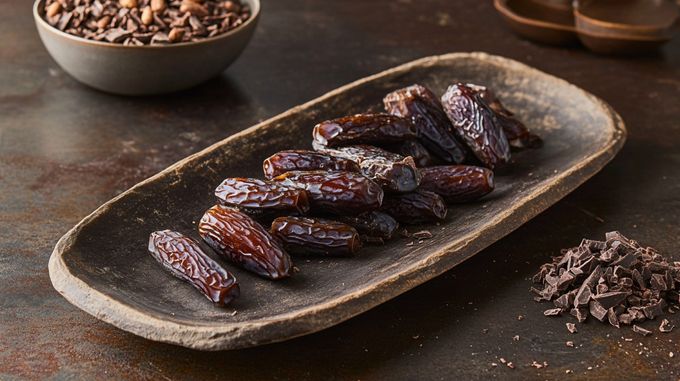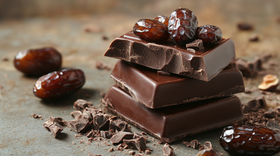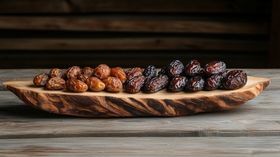Medjool Dates: 8 Reasons Why They're So Special
Discover the sweet, chewy, and nutrient-rich Medjool date, a nature's candy that's been nourishing bodies and souls for centuries.
Updated September 22, 2025

Close your eyes and imagine a fruit so luxurious it feels like nature's caramel, so rich in flavor that it transforms from a simple snack to a culinary experience.
The Medjool date is not just a fruit but a sensory journey—a complex, velvety delicacy that bridges the gap between nutrition and pure pleasure. Let's explore eight reasons this incredible fruit is so special.
» Treat yourself to the ultimate taste of luxury with Medjool date truffles
1. Unique size and texture
First impressions matter, and Medjool dates certainly look the part. Significantly larger than other date varieties, these fruits can measure up to 2–3 inches long, with a rich, deep brown color that speaks of richness and depth.
Touch a Medjool date, and you'll immediately notice something different. Unlike other dried fruits that can be tough or leathery, these dates have a smooth, almost silky skin that practically invites you to take a bite. The texture is remarkably soft—so soft that they nearly seem to melt in your mouth.
2. Delicious flavor profile
Their flavor is complex, nuanced, and captivating. Forget the one-dimensional sweetness of other fruits—Medjool dates offer a rich, caramel-like taste with subtle hints of honey and butterscotch. But this incredible taste isn't by accident.
The flavor develops through unique growing conditions, careful harvesting, and the date's natural sugar content. This means they can transform sweet and savory dishes with their remarkable flavor profile.
» Avoiding sugar? Find out why dates are a healthy alternative sweetener
3. Nutritional powerhouse
A typical serving of two Medjool dates (approximately 48 grams) contains around 133 calories. Beyond calories, they're packed with essential nutrients that contribute to overall health and wellness, making them a nutrient-dense alternative to refined sugars.
Nutritional breakdown
Here's what makes Medjool dates so healthy:
- Fiber Content: With approximately 3.2 grams of dietary fiber per serving, Medjool dates support digestive health and help maintain steady blood sugar levels. This high fiber content distinguishes them from refined sweeteners like white sugar, which offer no nutritional value.
- Natural Sugars: While Medjool dates are sweet, their sugars are natural and come with added benefits. They provide a more complex nutritional package than refined sugar or honey. The natural sugars are accompanied by minerals, vitamins, and antioxidants that support metabolic functions.
- Mineral Rich: These dates are an excellent potassium, magnesium, and copper source. [1] A serving provides about 20% of the recommended daily potassium intake, which is crucial for heart health and muscle function.
» Want to boost your antioxidant intake? Find out why cacao is the solution
Athletic performance and wellness
For fitness enthusiasts, Medjool dates offer unique benefits:
- Natural energy boost for pre and post-workout nutrition
- It helps in muscle recovery due to the high potassium content
- Provides sustained energy without refined sugar crashes
Compared to other sweeteners, Medjool dates offer a significantly more nutritious alternative. They deliver vitamins, minerals, and beneficial compounds that support overall health.
» Check out these top functional foods to transform your health
4. Culinary versatility
Medjool dates bridge the gap between sweet and savory with remarkable ease. Their rich, caramel-like flavor makes them incredibly adaptable in various culinary applications.
In sweet preparations, they shine in:
- Desserts like energy balls, date bars, and natural sweeteners for baked goods
- Smoothies and breakfast preparations
- Natural sweetening for raw and vegan recipes
» Try the delicious flavors of cacao gently sweetened by dates
In savory dishes, they offer unexpected depth:
- Stuffed with cheese and wrapped in prosciutto
- Chopped into salads for a sweet contrast
- Used in marinades for meats to add complexity and natural sweetness
Try this recipe for date and goat cheese stuffed peppadews
- Blend cream cheese, goat cheese, and finely chopped Medjool dates
- Stuff into sweet peppadew peppers
- Drizzle with honey and fresh thyme
5. A rich and complex history
Medjool dates can be traced back to Morocco, where date palm cultivation began thousands of years ago. Archaeological evidence suggests that dates have been a crucial food source in the Middle East and North Africa for over 6,000 years.
In traditional societies, date palms were more than just a food source. They were a symbol of life and survival in harsh desert environments. The trees provided fruit, shade, and construction materials and were integral to local economies.
From Morocco, they spread to other parts of the Middle East and eventually to the US in the early 20th century. In 1927, a disease devastated date palm crops in Morocco, prompting the USDA to import 11 offshoots of the Medjool variety, essentially saving this specific date type from potential extinction.
6. Everything is edible—even the pits!
Contrary to what many might think, Medjool date pits aren't just waste. While most people remove and discard the pit, these seeds have some surprising uses:
- Culinary Uses: In some cultures, date pits are ground into a flour-like powder used in baking or as a coffee substitute. The pits have a nutty, slightly bitter flavor that can add depth to various recipes.
- Cultural Significance: Date pits have been used in traditional medicine and craft-making for centuries in many Middle Eastern and North African cultures. They've been ground into powders, used in decorative items, and used as natural dyes.
- Agricultural Applications: Date pits can be used as a natural fertilizer or for growing new date palm trees. Farmers often use the pits to propagate new trees in regions where dates are traditionally grown.
» Looking for the energy of coffee without the crash? Try ceremonial cacao
7. Unique growing conditions
While cultivated initially in Morocco, they are now predominantly produced in regions with specific environmental conditions that mirror their native habitat. These regions share critical environmental characteristics: intense sunlight, low humidity, and well-drained, mineral-rich soils.
Where are Medjool dates grown?
The top producers of Medjool dates include:
- Morocco: The original homeland of these dates, where they have been cultivated for centuries in the fertile river valleys.
- United States: In California and Arizona, desert conditions closely mimic the dates' native environment.
Sustainable cultivation
Growing dates isn't just about producing a delicious fruit but also about sustainable agricultural practices:
- Water Conservation: Date palm farms in desert regions use sophisticated irrigation techniques.
- Soil Health: Date palms help prevent soil erosion in challenging environments.
- Biodiversity: These trees create micro-ecosystems that support local wildlife.
» Want to learn more about dates? Explore our comprehensive resources
8. Long-lasting shelf life
Unlike many fresh fruits that spoil quickly, Medjool dates have an impressive ability to stay fresh and delicious for an extended period. When stored properly, they can maintain their quality for several months, sometimes even up to a year.
The key to their remarkable shelf life lies in their unique composition. Their low moisture content and high sugar concentration act as natural preservatives.
Here's a breakdown of how to maximize their storage potential:
- Room Temperature Storage: When kept in an airtight container in a cool, dry place, they can last 1–2 months without refrigeration.
- Refrigeration: Storing them in the refrigerator extends their life to 6–12 months. The cool temperature helps preserve their soft texture and prevents moisture buildup.
- Freezing: They can be frozen for up to 12–18 months for long-term storage. Place them in a freezer-safe container or sealed plastic bag. When you're ready to use them, let them thaw at room temperature for the best texture.
Pro tip: Watch for any signs of crystallization on the surface. This is a sign of natural sugar concentration and doesn't mean the dates have gone bad. Warming them or letting them sit at room temperature is a quick way to restore their softness.
How KAICAO is redefining nature's candy
From the sun-baked deserts to modern wellness-focused kitchens, the Medjool date continues to evolve. KAICAO represents this evolution perfectly—taking this fruit rich in history and nutrition and elevating it into a luxurious truffle by pairing it with premium cacao, nuts, and spices.
The smooth, velvety texture of the cacao shell gives way to the soft, chewy interior, bursting with the intense sweetness of the Medjool date. Roasted nuts and aromatic spices add depth and complexity to the flavor profile. It's more than a treat—it's a culinary adventure that tells a story with every single bite.
» Indulge your senses and nourish your body with our Medjool date truffles




